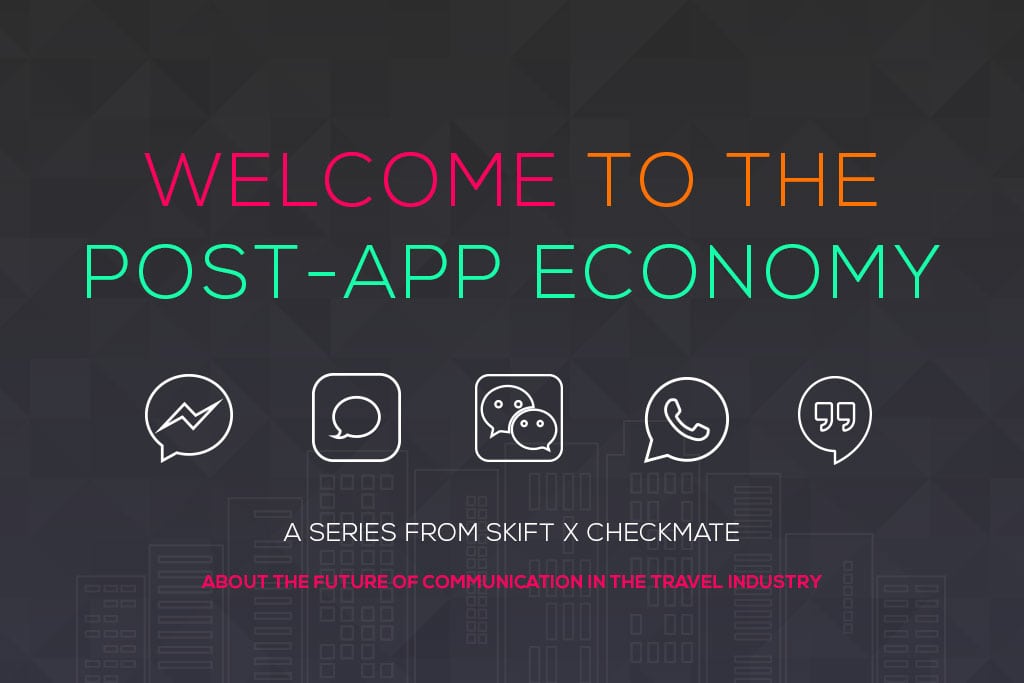Skift Take
Today's messaging platforms provide an appealing alternative to native apps, welcoming in a new framework for how the travel industry reaches its customers. Welcome to the Post-App Economy.
This sponsored content was created in collaboration with a Skift partner.
Whenever a traveler is faced with a challenge, big or small, a common phrase will be uttered by a friend or colleague: “There’s an app for that.”
This refrain has defined the mobile space for nearly a decade. But today, an emerging alternative is driving significant change and providing a more effective way for travel businesses to deliver mobile experiences. Welcome to the Post-App Economy.
Download the free infographic: 5 Trends Driving the Post-App Economy here:
Free Download
What is the Post-App Economy?
The Post-App Economy consists of rapidly growing messaging channels that provide brands and businesses with real-time opportunities to interact with customers. This economy includes both new platforms like Facebook Messenger’s ambitious scope, WeChat, and Google’s soon to be launched messaging app, as well as established channels like SMS and web chat. All of these channels allow for real-time, one-to-one communication, providing an alternative model for the development and distribution of a mobile experience.
When the iPhone launched in 2008, native apps were the only game in town. They are powerful tools, but apps have not taken root in categories with infrequent purchases. As apps proliferated – today the App Store alone has over 1.5 million apps – consumer engagement concentrated to only a few apps. Last year, consumers spent 79% of time on their mobile phone using five apps. Furthermore, only 10% of apps downloaded are ever used more than once. Thus, it is a growing challenge for businesses – especially those in infrequent purchase categories such as travel – to develop an app that is discovered, downloaded, and used.
Today, messaging platforms provide an appealing alternative. Analyst Benedict Evans provides an outstanding description of these trends in his 16 Mobile Theses (see numbers 7-10, in particular). For travel brands, three characteristics stand out around the benefits of the Post-App Economy:
- Easy engagement: Messaging services are present on every user’s phone, as every device comes with SMS (and Facebook Messenger, the other top messaging app, has over 1 billion users). Messaging with friends and family have habituated consumers to this communication channel, and travel brands must be ready to engage in the conversation.
- Multi-channel: Consumers use many channels in the post-app world. An individual consumer uses SMS, Facebook Messenger, and Whatsapp when interacting with friends and family. Unlike apps, where a phone purchase would lock a user into Android or iOS, individual consumers bounce across channels in the post-app economy. Travel brands must move seamlessly across all of these channels to connect with their customers.
- High signal: Messaging demands relevancy. The ping of a new message pulls the consumer away from his or her day and into the phone. Unlike apps that could sit undisturbed on the back screen of a user’s phone, messages clamor for attention. Messaging services know they cannot abuse this privilege with blast marketing, and travel brands must ensure their messages contain relevant content based on a consumer’s unique interests and needs.
Why is this Post-App Economy more hospitable to travel brands?
The structure of the post-app economy rewards travel brands’ core capabilities while de-emphasizing disadvantages.
- Messaging depends upon real-world, last mile activity. “High signal” messaging rewards real-time responses and emphasizes messages that result in action. High signal can arise out of real-world activity (e.g., “your room has been assigned”). Consumer requests through messaging platforms may demand real-world follow-up (e.g., “please have room service send up a burger”). These messages are only helpful when they result in a real-world action. In the post-app economy, value comes from the services in which travel brands excel.
- Brand strength – a dimension where travel brands thrive – matters more. Brand strength – the depth of a consumer’s relationship with that brand – is correlated with high signal. Because travel brands provide personal services like making the bed where a guest sleeps, they can build strong relationships through relevant, personal messages.
- Brand reach – a dimension where travel brands struggle – is relatively less important. Messaging channels solve discovery and engagement challenges, reducing the importance of brand reach. In the app economy, discovery was controlled through the popularity of Top 10 lists, which benefited intermediaries with the greatest breadth of inventory and product uses (e.g., explore, compare, and book across product categories). In the past, infrequent purchase patterns limited travel brands’ reach. However, in the post-app economy, reach matters less because businesses interact directly through the channels that are already an integral part of customers’ lives.
Want to learn more about the Post-App Economy? Download this infographic, 5 Trends Driving The Post-App Economy below:
This content was made collaboratively with our partner Checkmate.
Have a confidential tip for Skift? Get in touch
Tags: messaging, mobile apps, post app economy

